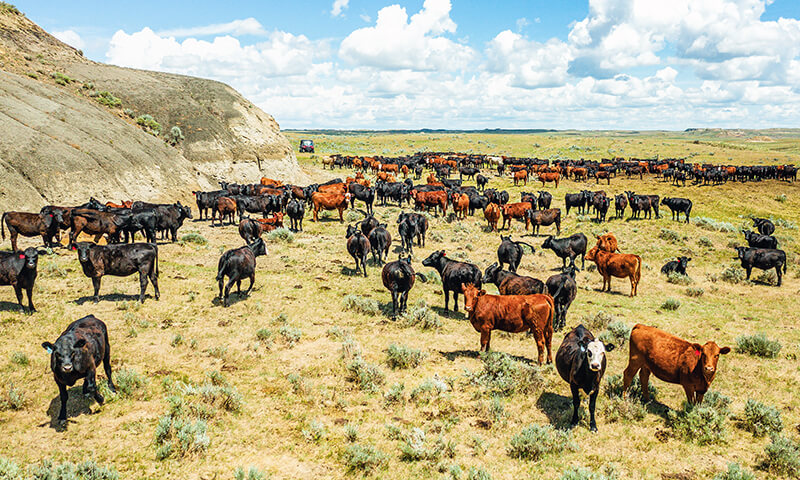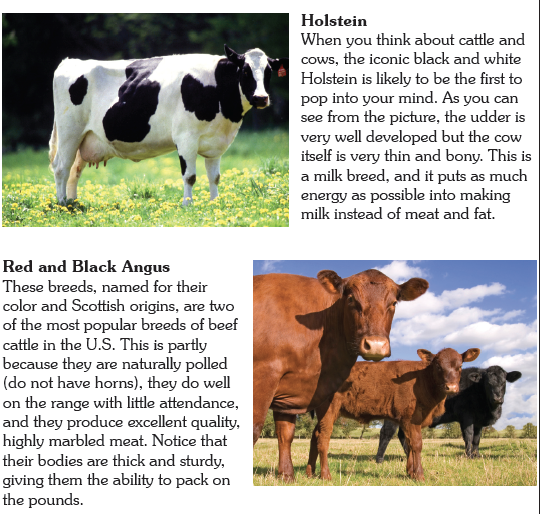Beef Basics
Students explain the value of the beef cattle industry, including the products cattle produce, the production process from farm to plate, and how cattle can utilize and obtain energy from grass and other forage.

Background
Lesson Activities
Recommended Companion Resources
Credits
Author
Lynn Wallin | Utah Agriculture in the Classroom
Sources
- https://www.usatoday.com/story/money/2017/07/03/americans-eat-more-beef-and-meat-trend-thats-expected-continue/435331001/
- https://www.huffingtonpost.com/2013/07/28/burger-facts-trivia_n_3654636.html
- http://beef2live.com/story-ranking-states-beef-cows-0-108181
Standards
Indiana Content Area Standards
-
Physical Education: Standard 3
The physically literate individual demonstrates the knowledge and skills to achieve and maintain a health-enhancing level of physical activity and fitness.
- 3.3.6.A Physical Education: Identifies foods that are beneficial for before and after physical activity.
- 5.3.6.A Physical Education: Analyzes the impact of food choices relative to physical activity, youth sports and personal health.
-
English Language Arts.Grade 3.RV.1
Build and use accurately conversational, general academic, and content-specific words and phrases.
- Vocabulary in Literature and Nonfiction Texts.3.RV.3.2: Determine the meanings of general academic and content-specific words and phrases in a nonfiction text relevant to a third grade topic or subject area.
-
English Language Arts.Grade 3.SL.1
Listen actively and adjust the use of spoken language (e.g., conventions, style, vocabulary) to communicate effectively with a variety of audiences and for different purposes.
- Comprehension.3.SL.3.2: Ask and answer questions about information from a speaker, offering appropriate elaboration and detail.
- Discussion and Collaboration.3.SL.2.1: Engage effectively in a range of collaborative discussions (one-on-one, in groups, and teacher-led) on grade- appropriate topics and texts, building on others ideas and expressing personal ideas clearly.
- Discussion and Collaboration.3.SL.2.2: Explore ideas under discussion by drawing on readings and other information.
-
English Language Arts.Grade 4.RN.1
Read and comprehend a variety of nonfiction within a range of complexity appropriate for grades 4-5. By the end of grade 4, students interact with texts proficiently and independently at the low end of the range and with scaffolding as needed at the high end.
- Key Ideas and Textual Support.4.RN.2.1: Refer to details and examples in a text when explaining what a text says explicitly and when drawing inferences from the text.
-
English Language Arts.Grade 4.RV.1
Build and use accurately general academic and content-specific words and phrases.
- Vocabulary in Literature and Nonfiction Texts.4.RV.3.2: Determine the meanings of general academic and content-specific words and phrases in a nonfiction text relevant to a fourth grade topic or subject area.
-
English Language Arts.Grade 4.SL.1
Listen actively and adjust the use of spoken language (e.g., conventions, style, vocabulary) to communicate effectively with a variety of audiences and for different purposes.
- Discussion and Collaboration.4.SL.2.1: Engage effectively in a range of collaborative discussions (one-on-one, in groups, and teacher-led) on grade- appropriate topics and texts, building on others ideas and expressing personal ideas clearly.
- Discussion and Collaboration.4.SL.2.2: Explore ideas under discussion by drawing on readings and other information.
-
English Language Arts.Grade 5.RV.1
Build and use accurately general academic and content-specific words and phrases.
- Vocabulary in Literature and Nonfiction Texts.5.RV.3.2: Determine the meaning of general academic and content-specific words and phrases in a nonfiction text relevant to a fifth grade topic or text.
-
English Language Arts.Grade 5.SL.1
Listen actively and adjust the use of spoken language (e.g., conventions, style, vocabulary) to communicate effectively with a variety of audiences and for different purposes.
- Discussion and Collaboration.5.SL.2.1: Engage effectively in a range of collaborative discussions (one-on-one, in groups, and teacher-led) on grade- appropriate topics and texts, building on others ideas and expressing personal ideas clearly.
